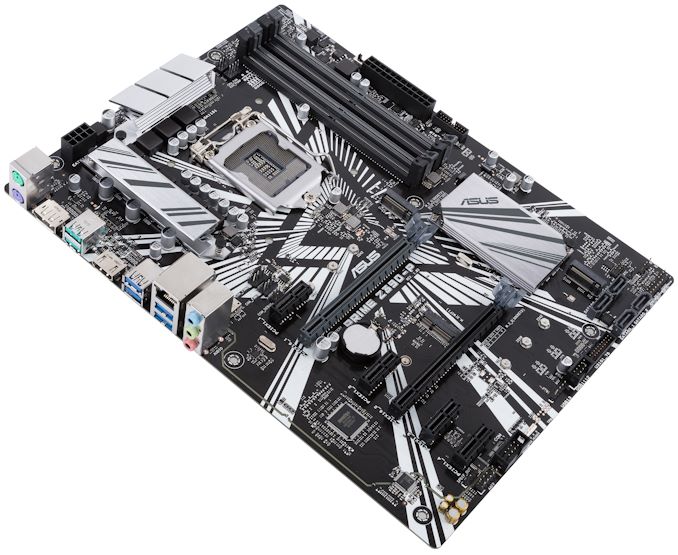Intel Z390 Motherboard Overview: 50+ Motherboards Analyzed
by Ian Cutress & Gavin Bonshor on October 8, 2018 10:53 AM EST- Posted in
- Motherboards
- Intel
- MSI
- Gigabyte
- ASRock
- EVGA
- Asus
- NZXT
- Supermicro
- Z390
ASUS Prime Z390-P
In comparison to the above ASUS Prime Z390-A, the aesthetically more 'out-there' Prime Z390-P has a white and black theme stretching as if a wave of triangles flew through the air and splattered across the board in what can only be described as rays. This board also features a set of basic looking heatsinks without a rear panel cover with all of the appeal coming from the onboard set of controllers and componentry, with a clear focus on the value being the ulterior motive of this particular offering.
The most basic of the ASUS Z390 range still retains impressive support for DDR4-4266 with up to a maximum of 64 GB across the four RAM slots allowed. The PCIe configuration is also basic with a full-length PCIe 3.0 x16 slot and two full-length PCIe 3.0 x4 slots and three PCIe 3.0 x1 slots offering support for two-way CrossFire multi-graphics card configurations. Storage support is offered through two M.2 slots with support for both PCIe 3.0 x4 and SATA drives, and a more basic looking set of four SATA ports which all feature cheaper straight-angled connectors.
A pair of USB 3.1 Gen2 Type-A and four USB 3.0 Type-A ports make up the boards USB connectivity with a pair of PS/2 ports and a DisplayPort and HDMI duo of video outputs on the board. The cheapest and basic of the ASUS Z390 motherboards has a Realtek RTL8111H Gigabit LAN port and Realtek ALC892 powered trio of 3.5 mm audio jacks which completes the rear panel.
The ASUS Prime Z390-P loos set to release as the cheapest Z390 board with the MSRP remainign unknown as of yet. The most basic and entry-level board offers a Realtek controller pairing which cuts down as much cost as possible, even with the use of straight-angled SATA ports to shave as much cost off as humanly possible. The Prime Z390-P is probably not the board to be considering for one of the new 8-core Intel Core i7-9900K processors, especially where overclocking is concerned due to the small and lightweight looking power delivery heatsinks.












79 Comments
View All Comments
pawinda8 - Monday, October 15, 2018 - link
Still no mention of any Z390 boards with native Thunderbolt 3 (not AIC)! Has Intel given up on Thunderbolt for the PC world?gavbon - Monday, October 15, 2018 - link
If it's not integrated into the chipset, it's not really native as such. The ASRock Z390 Phantom Gaming-ITX/ac has a Thunderbolt 3 port on the rear panel, but that's the only one I'm afraidHikariWS - Monday, October 15, 2018 - link
Oculus Rift requires 3 USB3 ports and doesn't accept any of them being connected to a hub, they all need to be connected directly into a raw port. I had to buy a dedicated 3GIO USB 3 board that added 6 useful extra ports. In my (yes, old) Gigabyte z87 mobo I also had issues using keyboard and mouse on USB 3 ports inside UEFI and some recovery softwares, so I had to buy a USB 2 mirror to connect them.Because of that, having USB 2 ports on front panel and nice quantity of USB 3 is what most differs mobos for me, given that all other features are nearly the same.
ASUS Z390-A seems to be the best option. It has the important double USB2 ports, 5 USB3 ports and still has HDMI and DP for emergencies.
just4U - Monday, October 15, 2018 - link
I wish MSI had released a "godlike" board for the Ryzen series.ThugEsquire - Tuesday, October 16, 2018 - link
You list the ASRock Z390 Phantom Gaming-ITX/ac above as an ATX board, but it's actually mITX. FYIgavbon - Friday, October 19, 2018 - link
I have gone through every page where the Phantom Gaming-ITX/ac is listed, but I can't see where it says it's an ATX board? Could you please be more specific? Are you viewing on mobile or desktop?Galcobar - Tuesday, October 16, 2018 - link
It would be really helpful to break out one more criteria into a table: Type-C header for case-front ports.Helping a friend put together an i5 system and, knowing he'll keep it for a long time, am trying to get even with peripheral connectors (already has a monitor, so no using that as a hub). It's relatively easy to identify cases with a Type-C port, but that's pointless without a motherboard header. Having to go into each board's page to check is time-consuming.
jjnam - Thursday, April 18, 2019 - link
6 months later and I'm here for EXACTLY this reason. I've gone through probably 50 manuals over the past few days squinting to find this information. What a pain.Synomenon - Thursday, October 18, 2018 - link
So on the ASRock Z390 Phantom Gaming-ITX/ac, is the TB3 port on the rear using up lanes from CPU (making the only 16x slot, 8x only)?If it's not using lanes from the CPU, how will using that TB3 port (say with a USB3.1 Gen2 hub OR TB3 hub) affect all the other ports / IO on the board?
repoman27 - Thursday, October 18, 2018 - link
Going off of what TweakTown published, it's a single-port Intel JHL6240 "Alpine Ridge" controller with a PCI 3.0 x2 connection to the PCH. So it won't affect the PEG lanes from the CPU. I'm amazed it's not Titan Ridge at this point though.